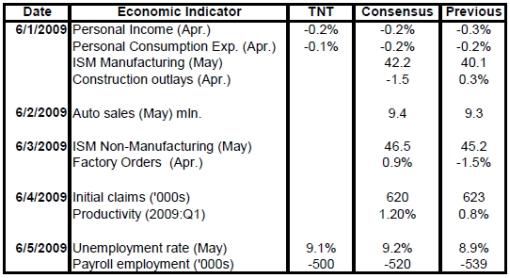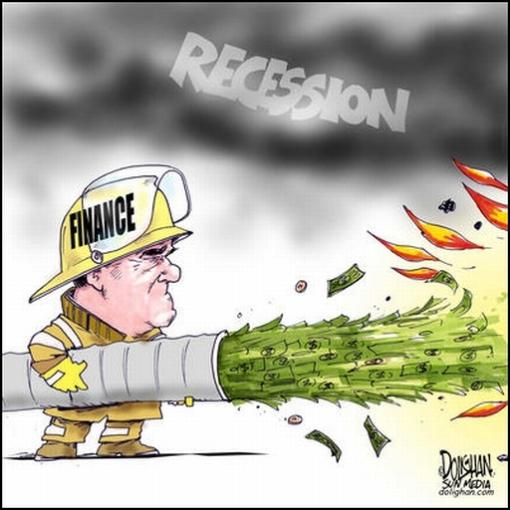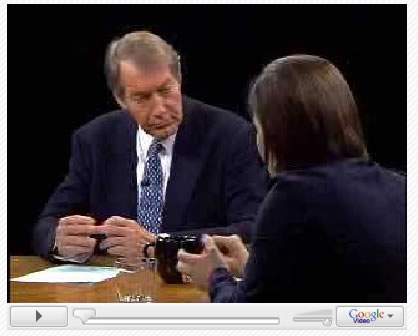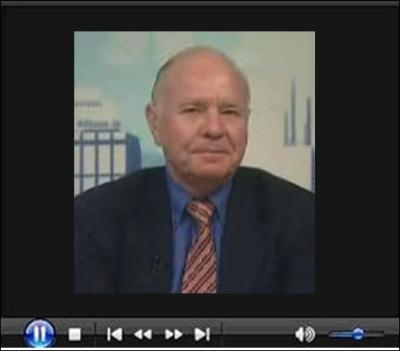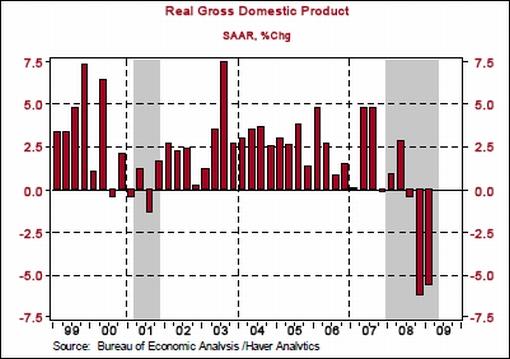Government Bond Markets Plunge Under Weight of Debt Issurance
Interest-Rates / International Bond Market May 31, 2009 - 10:38 AM GMT Government bonds dominated action on financial markets during the past holiday-shortened week, as angst about inflation and massive issuance propelled yields to six-month highs in the US, Europe and Japan.
Government bonds dominated action on financial markets during the past holiday-shortened week, as angst about inflation and massive issuance propelled yields to six-month highs in the US, Europe and Japan.
Bonds and other safe-haven assets such as the US dollar were out of favor as signs of a bottoming of global economies, albeit tentative, emboldened investors’ appetite for reflation trades like equities and commodities, including oil and precious metals.
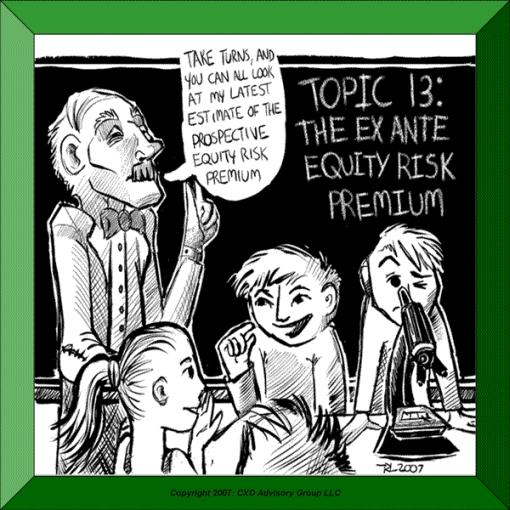
Source: CXO Advisory Group
In addition to the major stock market indices rising for a third consecutive month, some of the other milestones achieved during the past week were the following:
• The S&P 500 Index rose by 5.3% in May for a three-month performance of +25.0% - the biggest three-month gain since August 1938.
• The Dow Jones Industrial Index advanced by 4.1% and 20.4% for May and the three-month period respectively - its largest three-month return since November 1998. (The last straight three-month gain was from August to October 2007, when the Index reached its bull market peak).
• The US dollar declined to a five-month low against the euro, losing 6.6% during May. The buck’s declines was even more pronounced against high-yielding currencies such as the Australian dollar (-9.4%) and the New Zealand dollar (-11.3%).
• The yield spread between two- and ten-year Treasury Notes reached a record 275 basis points on Wednesday before narrowing to 254 basis points by the close of the week.
• The Reuters-Jeffries CRB Index increased by 13.8% during May - its best monthly gain since 1974.
• The Baltic Dry Index - measuring freight rates of iron ore and bulk commodities - climbed every day in May to post its biggest monthly advance (+95.6%) on record.
• The price of West Texas Intermediate Crude recorded its largest monthly increase (+29.7%) since March 1999.
• Silver surged by 26.8% for the month - its strongest performance for 22 years. (Gold bullion advanced by 10.2% during May, and platinum by 8.2%.)
Back to long-term bonds. According to the Financial Times, Mike Lenhoff, chief market strategist at Brewin Dolphin Securities, said: “Bond markets may be telling us to expect inflation but, more importantly, I think they are telling us that policy makers the world over will succeed with their efforts to reflate the global economy.
“The trend of yields on corporate debt has been down, and that on Treasuries up, implying diminishing risk premiums - which is just what you would expect if markets are banking on recovery.”
The week’s performance of the major asset classes is summarized by the chart below.
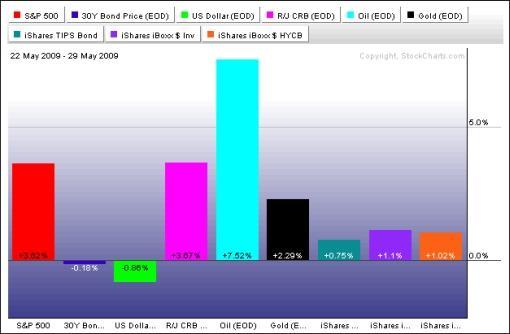
Source: StockCharts.com
The MSCI World Index (+1.7%) and the MSCI Emerging Markets Index (+6.6%) last week added to the previous week’s gains to take the year-to-date returns to +5.4% and a massive +36.3% respectively.
Although the major US indices experienced declines on Monday and Wednesday, the weekly scoreboard ended in positive territory, as seen from the movements of the indices: S&P 500 Index (+3.6%, YTD +1.8%), Dow Jones Industrial Index (+2.7%, YTD -3.1%), Nasdaq Composite Index (+4.9%, YTD +12.5%) and Russell 2000 Index (+5.0%, YTD +0.4%).
The Dow remains the only major US index still in the red for the year to date - and, along with the FTSE 100, one of the few global indices in this unenviable position.
Click here or on the table below for a larger image.
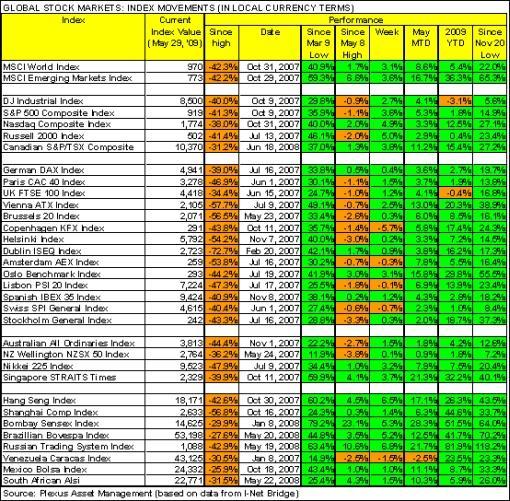
Source: StockCharts.com
As far as non-US markets are concerned, returns ranged from top performers Macedonia (+10.8%), Croatia (+10.2%), Nigeria (+9.9%), Namibia (+8.5%) and Peru (+7.8%), to the Czech Republic (-6.6%), Denmark (-5.7%), Saudi Arabia (-4.4%), Latvia (-4.2%) and Côte d’Ivoire (-3.5%), which experienced headwinds. (Click here to access a complete list of global stock market movements, as supplied by Emerginvest.)
Emerging markets (especially the BRIC countries) are showing mature markets a clean pair of heels, as can be seen from the rising trend line of the MSCI Emerging Markets Index relative to the Dow Jones World Index since late October. The fact that developing countries are outperforming the developed ones is a sign that global investors are taking more risk - a necessary ingredient for stock markets in general to show a further improvement.
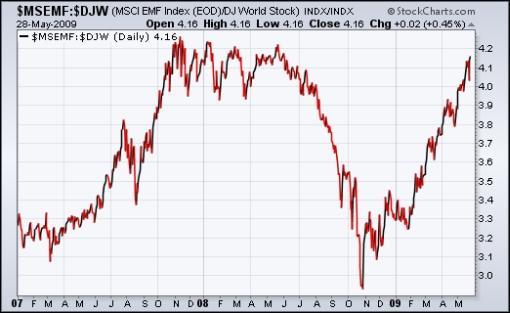
Source: StockCharts.com
John Nyaradi (Wall Street Sector Selector) reports that as far as exchange-traded funds (ETFs) are concerned, the leaders for the week included Claymore/Delta Global Shipping (SEA) (+10.5%), iShares MSCI Hong Kong (EWH) (+10.4%) and HOLDRS Merrill Lynch Market Oil Service (OIH) (+10.4%). Poor performers were all things “short”, with notable laggards being ProShares Short MSCI Emerging Markets (EUM) (-4.5%), ProShares Short QQQ (PSQ) (-4.1%) and ProShares Short Russell 2000 (RWM) (‑3.5%).
Further confirmation that the various central bank liquidity facilities and capital injections are having the desired effect of unclogging credit markets, comes from the Goldman Sachs’s Financial Stress Index (FSI). This index includes four factors related to the degree of impairment of financial markets: counterparty risk (US dollar 3-month LIBOR-OIS), liquidity risk (mortgage-backed security [MBS] to treasury repo differentials), refunding risk (commercial paper outstanding) and broader risk aversion (percentage of monies held in money-market mutual funds in relation to equity market capitalization).
As shown in the graph below, the FSI is now at its lowest level since the beginning of the credit crisis in August 2007.
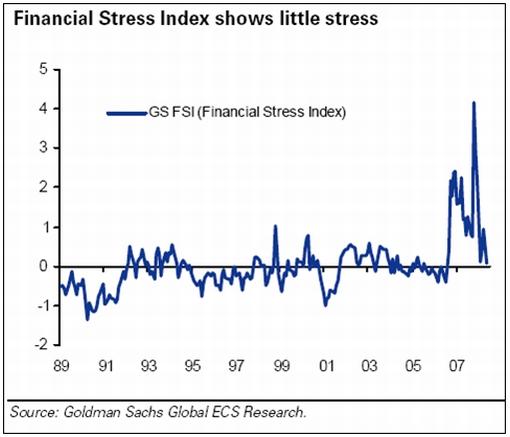
Source: Goldman Sachs - Strategy Matters, May 15, 2009.
The decline of the US dollar and the rise in bond yields took on new momentum during the past few weeks. Deepening anti-dollar sentiment caused bets against the greenback on the Chicago Mercantile Exchange to rise to their highest level since the onset of the financial crisis, reported the Financial Times.
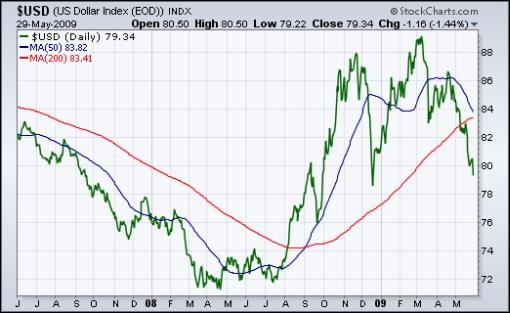
Source: StockCharts.com
Richard Russell (Dow Theory Letters) said: “The US Dollar Index is sitting on what I term ‘the edge of the cliff’. If the dollar falls apart, we’re dealing with a whole new story - it will affect almost all investments, US and foreign. The sliding dollar is already putting pressure on Treasury bonds, particularly the long-term maturities. This is causing our creditors (think China) to cut back.” The graph below shows that the sovereign debt bubble may be in the midst of bursting.
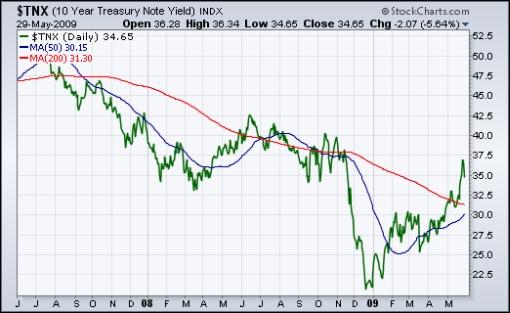
Source: StockCharts.com
The higher Treasury yields had a negative impact on mortgage rates, with the 30-year fixed rate increasing by 29 basis points to 5.27% on the week and the 15-year fixed rate by 25 basis points to 4.87%, as indicated by Bankrate.com. Yields on mortgage bonds for the first time exceeded the levels at which they were trading before the Fed’s announcement of expanding Treasury purchases to reduce lending rates. This raises the question of whether the Fed might soon increase its Treasury buy-backs.
The quote du jour comes from the “out-the-box” analyst Marc Faber who argued that the US economy would enter “hyperinflation” approaching the levels in Zimbabwe. “I am 100% sure that the US will go into hyperinflation,” Faber said in an interview with Bloomberg. “The problem with government debt growing so much is that when the time comes and the Fed should increase interest rates, they will be very reluctant to do so and so inflation will start to accelerate.”
In other news, according to The Washington Post, senior administration officials are considering the creation of a single agency to regulate the banking industry, replacing a mishmash of bodies that failed to prevent banks from plunging into the worst financial crisis since the Great Depression.
Next, a tag cloud of all the articles I read during the past week. This is a way of visualizing word frequencies at a glance. Key words such as “financial”, “gold”, “dollar”, “banks” and “credit” featured prominently. Surprisingly, “bonds” did not make the cloud despite playing a key role in market movements over the past few days.
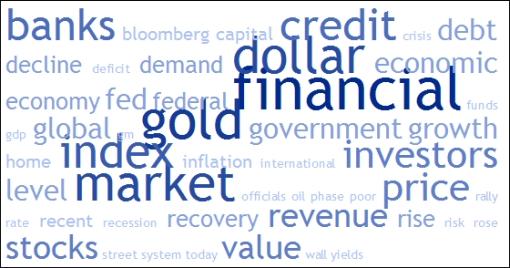
Zeroing in on the US stock markets, this week’s survey of investor sentiment from the American Association of Individual Investors (AAII) shows an increase in both bearish and bullish sentiment. Bespoke reports that in the last week bullish sentiment increased from 33.7% to 40.4%, whereas bearish sentiment climbed from 45.4% to 48.6%. Bears therefore still outnumber bulls and are at their highest level since March 12.
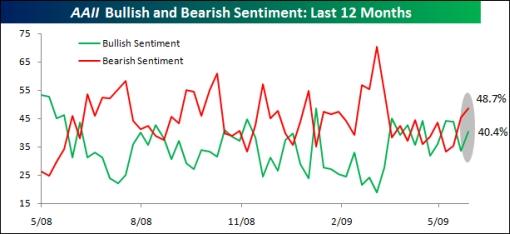
Source: Bespoke, May 28, 2009.
An analysis of the moving averages of the major US indices shows all the indices above their 50-day moving averages, with the Nasdaq Composite after last week’s gains now also above the key 200-day line and the early January high. The highs of May 8 (already breached by the Nasdaq) are the most immediate targets to the upside, whereas the levels from where the rally commenced on March 9 should hold in order for base formations to remain in force.
Eoin Treacy (Fullermoney) said: “… the logical areas for indices to encounter resistance are near round numbers. For the S&P, this would be 950 or 1,000. The FTSE 100 is currently encountering supply beneath 4,500. For India, 15,000 is the pertinent number. Brazil is currently in the region of 53,000, and if it breaks upwards from here, the next logical area for people to look at is 60,000.”
Adam Hewison of INO.com has again prepared another of his popular technical analyses - this time on the British pound, oil and gold bullion. Click here to access the short presentation.
Richard Russell, who has taken the stand that we are experiencing a bear market rally, said: “Lowry’s valuable statistics have been available for over 70 years. Normally, as a bear market nears its final low, Lowry’s Selling Pressure Index sinks dramatically, thereby providing evidence that the supply of stocks for sale is sinking. The Selling Pressure Index continues to decline after the bottom has passed. This is NOT what has happened before or since the March 9 lows.
“On the low of March 9 Lowry’s Selling Pressure Index stood at 884. At yesterday’s close the Selling Pressure Index stood at 868, only 14 points lower than it was on March 9. Meanwhile, on March 9 Lowry’s Buying Power Index stood at 120. At yesterday’s close, Buying Power was at 156, which was a gain of 36 points from the March 9 low.
“To move the stock market higher in a healthy way, Buying Power must rise while Selling Pressure must decline. As things stand, there’s still too much Selling Pressure (supply) built into this market.”
With the first-quarter earnings reporting season now winding down, analysts are shifting their focus to Q2. Albert Edwards, Société Générale’s strategist, observes (via Barron’s) that bottom-up company analysts forecast an unprecedentedly mild contraction in profit margins in the midst of the worst recession since the Great Depression. “This just doesn’t make sense to us. Analysts are ‘anchoring’ on recent unprecedented highs in margins as the new norm, instead of viewing them as bubble nonsense never to be seen again.” Time will tell whether the consensus earnings expectation for the S&P 500 of a 34.7% decline for Q2 2009 versus Q2 2008 is too optimistic.
As General Motors moved closer to a bankruptcy filing, possibly on Monday, I couldn’t help recalling the statement by former GM CEO “Engine Charlie” Watson: “What’s good for the country is good for General Motors, and vice versa.” Oh well.
For more discussion on the direction of stock markets, also see my recent posts “Video-o-rama: higher bond yields raise caution“, “Why Jeremy Grantham changed his mind“, “Dollar’s slide hurting foreign investors“, “Goldman: Past the worst?” and “Technical talk: S&P 500 testing resistance“. (Also, Donald Coxe’s webcast has been updated for May 28 and makes for good listening. This can be accessed from the sidebar of the Investment Postcards site.)
Twitter I regularly post short comments (maximum 140 characters) on topical economic and market issues, web links and graphs on Twitter. For those not doing so already, you can follow my “tweets” by clicking here. The Twitter posts also appear on my Facebook page and in the sidebar of the Investment Postcards site.
Economy
“Sentiment among global businesses remains very poor, but it continues to slowly improve. Confidence has moved measurably higher since mid-March and is now close to where it was last November. Businesses are notably more upbeat about the outlook towards the end of this year …,” said the latest Survey of Business Confidence of the World conducted by Moody’s Economy.com. The global economy remains mired in recession according to the Survey results, but the recession is becoming less intense.
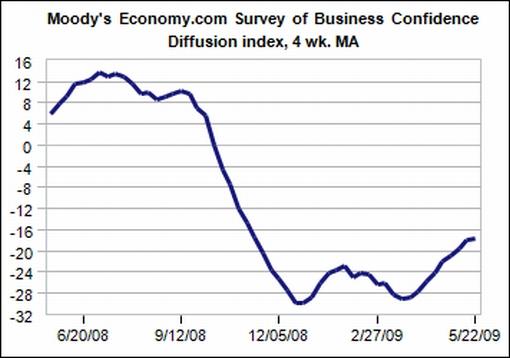
Source: Moody’s Economy.com
“Taken separately, one can find many reasons not to rely on survey results, especially those from consumers. But put them together, and global survey results indicate that economic stabilization is afoot,” said Rebecca Wilder (News N Economics).
As seen from the chart below, the consumer and business survey results for the US, Japan and Germany have been improving for several months now, with the US showing a sizeable increase in May. The Eurozone has just seen its first improvement in economic sentiment since May 2007.
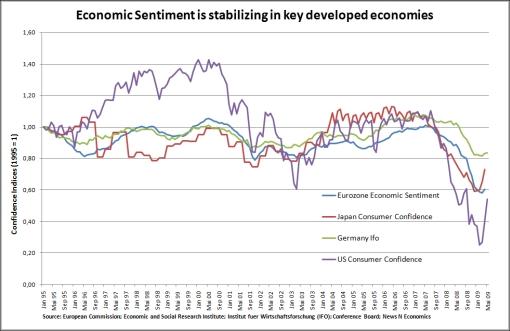
Source: News N Economics
Considering hard data, signs have also emerged that the global economy is stabilizing. Examples include a rebound in Japanese industrial production, the first rise in German retail sales in four months, and a rise in UK house prices in May.
Turning to the US, a snapshot of the week’s economic data is provided below. (Click on the dates to see Northern Trust’s assessment of the various data releases.)
May 29 • Q1 real GDP preliminary estimate - minor revisions, message is unchanged
May 28 • New Home Sales flat in April, inventories are shrinking slowly • Jobless Claims fall but continuing claims continue to advance • Durable Goods Orders were weak in April, Defense Orders lifted total bookings
May 27 • Sales of Existing Homes moved up, but inventories remain elevated
May 26 • Chicago National Activity Index sends an upbeat message • Consumer Confidence Index posts significant jump in May • Case-Shiller Home Price Index - noteworthy price movements, but more is required
Referring specifically to US housing, John Mauldin (Thoughts from the Frontline) said: “Housing in many areas is starting to once again become affordable (see chart below) to more and more Americans and even first-time home buyers. The cure for the housing crisis is actually lower prices, as that brings more and more potential home buyers into the market. While housing sales are still quite depressed, what are selling are homes in foreclosure, as buyers perceive that there are bargains. And they are right.”
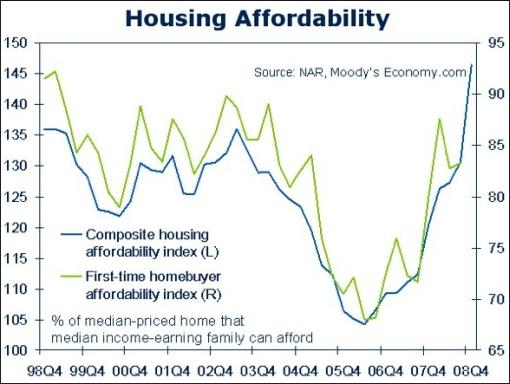
Source: Moody’s Economy.com
In his weekly Forbes column, Nouriel Roubini (RGE Monitor) commented as follows: “The crucial issue facing us is not whether the global economy will bottom out in the third or fourth quarter of this year, or in the first quarter of next year. It’s whether the global growth recovery, once the bottom is reached, will be robust or weak over the medium term - say 2010-11. … one cannot rule out a sharp snapback of GDP for a couple of quarters, as the inventory cycle and the massive policy boost lead to a short-term growth revival. My analysis, however, suggests that there are many yellow weeds that may lead to a weak global growth recovery over 2010-11.”
On a related note, Gillian Tett (Financial Times) asked whether one should expect a “V”-shaped recovery, or a scenario more like a “U” or a “W”. “Many years ago, when I was a rookie reporter, I learnt the Pitman system of shorthand. And it just happens that the half-squashed, asymmetrical ‘W’ pattern that I am struggling to describe is almost identical to the shorthand sign for ‘bank’.
“So there you have it: as long as we avoid a government bond crisis, my best prognosis is for a ‘bank’ shaped recovery-*****-stagnation, at least as depicted by shorthand. It is a fitting twist for a crisis that started with the shadow banks; perhaps the Gods of finance (and journalism) have a sense of humor after all,” said Tett.
Week’s economic reports
Click here for the week’s economy in pictures, courtesy of Jake of EconomPic Data.
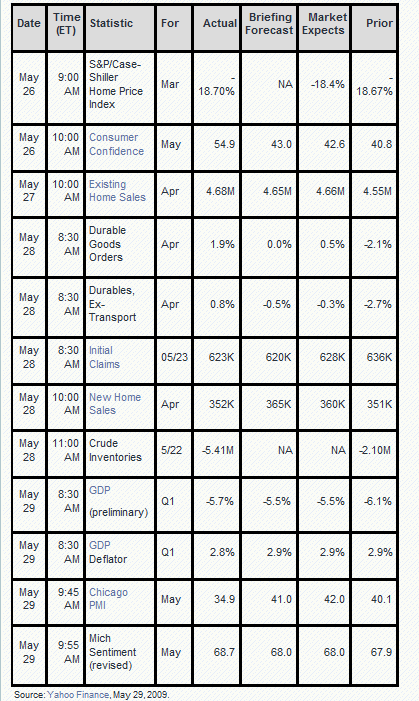
In addition to Federal Reserve Chairman Ben Bernanke’s testimony before the House Budget Committee (Wednesday, June 3), and interest rate announcements by the Bank of England and the European Central Bank (Thursday, June 4), the US economic highlights for the week include the following:
Source: Northern Trust
Click here for a summary of Wachovia’s weekly economic and financial commentary.
Markets
The performance chart obtained from the Wall Street Journal Online shows how different global financial markets performed during the past week.
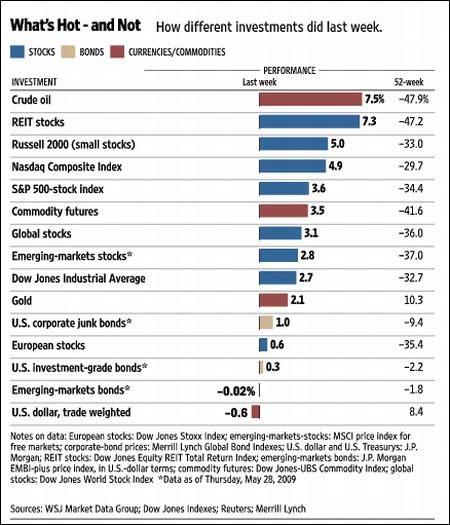
Source: Wall Street Journal Online, May 29, 2009.
British philosopher Bertrand Russell said: “If a man is offered a fact which goes against his instincts, he will scrutinize it closely, and unless the evidence is overwhelming, he will refuse to believe it. If, on the other hand, he is offered something which affords a reason for acting in accordance to his instincts, he will accept it even on the slightest evidence.”
Hopefully the “Words from the Wise” reviews offer material of the necessary substance that will guard against Investment Postcards readers merely having to rely on their instincts when taking investment decisions.
That’s the way it looks from Cape Town as May draws to a close.
Source: Mapleleafweb
Charlie Rose: A conversation about Bear Sterns and the economic crisis with Kate Kelly and William Cohan “A conversation about Bear Sterns and the economic crisis with Kate Kelly, author of Street Fighters: The Last 72 Hours of Bear Stearns, the Toughest Firm on Wall Street and William Cohan, author of House of Cards: A Tale of Hubris and Wretched Excess on Wall Street.”
Source: Charlie Rose, May 28, 2009.
The Wall Street Journal: How to fix the financial system “The Committee on Capital Markets Regulation, a diverse group of academics, former government officials, and business leaders, plans to present a comprehensive list of recommendations Tuesday calling for an overhaul of the rules supervising financial markets. The recommendations will likely attract attention from key government officials because of the people’s credentials who put together the report, called “The Global Financial Crisis: A Plan For Regulatory Reform.”
“Among others, the report was penned by R. Glenn Hubbard, dean of the Columbia Business School, John L. Thornton, Chairman of the Brookings Institution, Hal S. Scott, Nomura Professor and Director of the Program on International Financial Systems at Harvard Law School, and Roel Campos, a former commissioner at the Securities and Exchange Commission. The report is thorough - the executive summary alone has 57 recommendations.
“Some of the key recommendations:
“1) Keep two or three regulators for the financial system - the Fed, a new US Financial Services Authority, and an investor and consumer protection agency. The USFSA ‘would regulate all aspects of the financial system, including market structure and activities and safety and soundness for all financial institutions.’
“2) Mandate centralized clearing of credit default swaps. To the extent that some CDSs stay outside a centralized clearing process, the committee calls for higher capital requirements to ‘compensate for increased systemic risk of these contracts’.
“3) Don’t make a hasty decision to raise capital requirements across the financial sector until more analysis is done. But the committee does recommend higher capital requirements for megabanks, such as those with more than $250 billion in assets. ‘Given the concentration of risks to the government and taxpayer, we recommend that large institutions be held to a higher solvency standard than other institutions, which means they should hold more capital per unit of risk.’
“4) Strengthen the ‘leverage’ capital ratio, and debate whether the leverage ratio should be based on common equity rather than total Tier 1 capital.
“5) Give the Fed temporary authority to evaluate confidential information supplied by hedge funds.
“6) Relax acquisition rules to make it easier for private equity firms to pump money into the banking sector.
“7) Create a comprehensive policy called the Financial Company Resolution Act, that would be allowed to put any financial company into receivership, not just ’systemically’ important ones.
“8) Ban or limit high-risk mortgages from being securitized.”
Source: Damian Paletta, The Wall Street Journal, May 26, 2009.
The Washington Post: US weighs single agency to regulate banking industry “Senior administration officials are considering the creation of a single agency to regulate the banking industry, replacing a patchwork of agencies that failed to prevent banks from falling into the worst financial crisis since the Great Depression, sources said.
“The agency would be a key element in the administration’s sweeping overhaul of financial regulation, which officials hope to unveil in coming weeks, including the creation of a new authority to police risks to the financial system as well as a new agency to protect consumers, according to three people familiar with the matter. Most of the proposals would require legislation.
“‘The president is committed to signing a regulatory reform package by the end of the year, and officials at the White House and the Treasury Department are continuing work with Congress on the final phases of a proposal, but there is no final proposal in place and any announcement will not be for a couple of weeks,’ said White House deputy spokesman Jennifer Psaki.
“Senior officials have reached agreement on aspects of the plan, according to a person familiar with the discussions.
“They favor vesting the Federal Reserve with new powers as a systemic risk regulator, with broad responsibility for detecting threats to the financial system. The powers would include oversight of previously unregulated markets, such as the derivatives trade, and of market participants such as hedge funds.
“Officials also favor the creation of a new agency to enforce laws protecting consumers of financial products such as mortgages and credit cards.
“And they want to merge the Securities and Exchange Commission and the Commodity Futures Trading Commission, which share responsibility for protecting investors from fraud.
“Other aspects of the plan remain under discussion, sources said, speaking on condition of anonymity because they were not authorized to disclose details.”
Source: Binyamin Appelbaum and Zachary Goldfarb, The Washington Post, May 28, 2009.
The Wall Street Journal: Fed cools banks’ faith in future revenue “Big banks were hoping billions of dollars in future revenue would help them fill the capital holes found in the government’s stress tests earlier this month. Now the Federal Reserve is limiting how much of that performance can be counted, according to people familiar with the situation.
“The Fed’s decision is forcing Bank of America Corp. to come up with billions of dollars in capital from other sources, these people said. Other stress-tested banks also have revamped their capital-raising plans or might need to, including PNC Financial Services Group Inc. and Wells Fargo & Co.
“The move by the Fed, which began notifying banks last week, has deepened tensions over the stress tests, which are intended to help steady the banking industry and shore up confidence in the financial system. The results were announced May 7, and banks face a June 8 deadline for government approval of their capital-raising plans.
“Some banks had planned for financial performance in 2009 and 2010 to cover 20% or more of their capital shortfalls.
“Since announcing the stress-test results, though, Fed officials have grown concerned that some banks are leaning too heavily on future revenue projections, according to people familiar with the matter. Under the new requirement, projected revenue can be used for no more than 5% of the additional equity being demanded from the 10 banks.”
Source: Dan Fitzpatrick, The Wall Street Journal, May 28, 2009.
The New York Times: GM plan gets support from key bondholders “As General Motors moved closer to a bankruptcy filing, possibly early next week, attention on Thursday turned again to the bondholders, the most important group that the company has yet to win over for its efforts to start fresh.
“Early Thursday, GM proposed a deal in which bondholders would receive up to a 25% stake - a bigger share than GM offered the autoworkers union - if they do not oppose its bankruptcy reorganization, and then said that a group representing many of the largest bondholders had accepted the offer.
“The proposal came as administration officials and GM began to discuss how the carmaker would look once it emerged from a court reorganization. The company is expected to seek bankruptcy protection by Monday, the deadline set by the Obama administration to restructure outside bankruptcy.
“In a regulatory filing, GM set Saturday afternoon as the deadline for other bondholders to support the plan. In addition to an ad hoc committee that supports the GM plan, which represents about 20% of GM’s debt, people with knowledge of the discussions said a second group, with about 30% of GM’s debt, was in talks with the Treasury.
“Administration officials said they considered the development positive. While the officials said there was no specific threshold for approval by the bondholders, a person briefed on the matter said that GM was seeking support from investors holding about 50% of GM’s $27 billion in bond debt.
“GM and the Treasury will re-examine the results after 5 p.m. on Saturday to gauge support before deciding how to proceed.”
Source: Michael de la Merced and Micheline Maynard, The New York Times, May 28, 2009.
Nouriel Roubini (Forbes): Ten risks to global growth “Last week, I discussed why the US and global recovery will occur later than the optimistic consensus argues. This week, I will discuss why the recovery will be sub-par and below trends for a few years once it does occur, and why there is even the risk of a double-dip W-shaped recession.
“The crucial issue facing us is not whether the global economy will bottom out in the third or fourth quarter of this year, or in the first quarter of next year. It’s whether the global growth recovery, once the bottom is reached, will be robust or weak over the medium term - say 2010-11. … one cannot rule out a sharp snapback of GDP for a couple of quarters, as the inventory cycle and the massive policy boost lead to a short-term growth revival. My analysis, however, suggests that there are many yellow weeds that may lead to a weak global growth recovery over 2010-11.
“The current consensus among ‘green shoot’ optimists sees US economic growth going back in 2010 to a rate that is close to the 2.75% potential growth rate, and returning to potential by 2011. Many optimists go even further, arguing that the snapback of demand and production after the depressed levels of the current recession will lead growth to be well above trend (3.5% to 4%) for a couple of years, as most previous US recessions have been followed by a period of above-trend growth once the recovery gets going. Yet a detailed analysis suggests that growth will remain well below potential for at least two years - if not longer - as the severe vulnerabilities and excesses of the last decade will take years to resolve. Let us examine 10 factors that will cause below-potential economic growth over the medium term even after this recession is over.”
Click here for the full article.
Source: Nouriel Roubini, Forbes, May 28, 2009.
Bloomberg: US spends 14% of economic stimulus money in first 100 days “About 14% of President Barack Obama’s $787 billion economic stimulus package has been allocated, creating 150,000 jobs in the 100 days since the measure was signed into law, the administration said.
“A report released today said the $112 billion in stimulus funds committed so far is going to projects across the country, from making public housing more ‘green’ in Washington to helping build a new library in Darlington County, South Carolina and buying a snow plow in Munising, Michigan.
“Obama said when he signed the bill Feb. 17 that it would create or save 3.5 million jobs by the end of September 2010. Today’s report didn’t measure how many jobs the stimulus has preserved.”
Source: Angela Greiling Keane, Bloomberg, May 27, 2009.
Bloomberg: Faber - US inflation to approach Zimbabwe level “The US economy will enter ‘hyperinflation’ approaching the levels in Zimbabwe because the Federal Reserve will be reluctant to raise interest rates, investor Marc Faber said. Prices may increase at rates ‘close to’ Zimbabwe’s gains, Faber said in an interview with Bloomberg Television in Hong Kong.”
Source: Bloomberg, May 27, 2009.
Casey’s Charts: A 2,050% rise in price “The costs of things as measured by the consumer price index have risen twentyfold since the Federal Reserve Act of 1913. This act empowered the central bank to create and control a new currency for the United States, the Federal Reserve Note. Over this same period, the federal deficit soared from $2 billion to over $11 trillion. Coincidence? We think not.
“After President Nixon cut the dollar’s ties to gold, funding the whims of government was no longer burdened by the need for higher taxes. Now any gaps in the budget can be filled by simply printing more dollars. And as you can see, the politicians didn’t hesitate to meet the challenge. Price levels and federal debt have risen hand-in-hand ever since.”
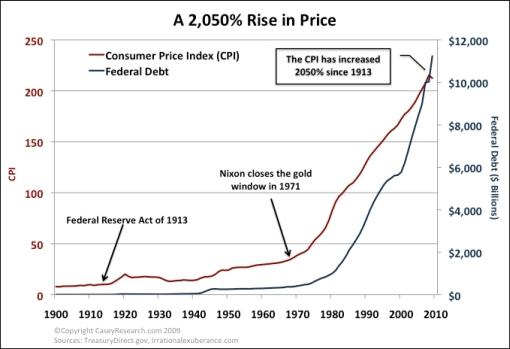
Source: Casey’s Charts, May 28, 2009.
John Taylor (Financial Times): Exploding debt threatens America “Standard and Poor’s decision to downgrade its outlook for British sovereign debt from ’stable’ to ‘negative’ should be a wake-up call for the US Congress and administration. Let us hope they wake up.
“Under President Barack Obama’s budget plan, the federal debt is exploding. To be precise, it is rising - and will continue to rise - much faster than gross domestic product, a measure of America’s ability to service it. The federal debt was equivalent to 41% of GDP at the end of 2008; the Congressional Budget Office projects it will increase to 82% of GDP in 10 years. With no change in policy, it could hit 100% of GDP in just another five years.
“‘A government debt burden of that [100%] level, if sustained, would in Standard & Poor’s view be incompatible with a triple A rating,’ as the risk rating agency stated last week.
“I believe the risk posed by this debt is systemic and could do more damage to the economy than the recent financial crisis. To understand the size of the risk, take a look at the numbers that Standard and Poor’s considers. The deficit in 2019 is expected by the CBO to be $1,200 billion. Income tax revenues are expected to be about $2,000 billion that year, so a permanent 60% across-the-board tax increase would be required to balance the budget. Clearly this will not and should not happen. So how else can debt service payments be brought down as a share of GDP?
“Inflation will do it. But how much? To bring the debt-to-GDP ratio down to the same level as at the end of 2008 would take a doubling of prices. That 100% increase would make nominal GDP twice as high and thus cut the debt-to-GDP ratio in half, back to 41 from 82%. A 100% increase in the price level means about 10% inflation for 10 years. But it would not be that smooth - probably more like the great inflation of the late 1960s and 1970s with boom followed by bust and recession every three or four years, and a successively higher inflation rate after each recession.
“The fact that the Federal Reserve is now buying longer-term Treasuries in an effort to keep Treasury yields low adds credibility to this scary story, because it suggests that the debt will be monetised. That the Fed may have a difficult task reducing its own ballooning balance sheet to prevent inflation increases the risks considerably. And 100% inflation would, of course, mean a 100% depreciation of the dollar. Americans would have to pay $2.80 for a euro; the Japanese could buy a dollar for Y50; and gold would be $2,000 per ounce. This is not a forecast, because policy can change; rather it is an indication of how much systemic risk the government is now creating.
“Why might Washington sleep through this wake-up call? You can already hear the excuses.”
Click here for the full article.
Source: John Taylor, Financial Times, May 26, 2009.
USA Today: IRS tax revenue falls along with taxpayers’ income “Federal tax revenue plunged $138 billion, or 34%, in April versus a year ago - the biggest April drop since 1981, a study released Tuesday by the American Institute for Economic Research says.
“When the economy slumps, so does tax revenue, and this recession has been no different, says Kerry Lynch, senior fellow at the AIER and author of the study. ‘It illustrates how severe the recession has been.’
“For example, 6 million people lost jobs in the 12 months ended in April - and that means far fewer dollars from income taxes. Income tax revenue dropped 44% from a year ago.
“‘These are staggering numbers,’ Lynch says.
“Big revenue losses mean that the US budget deficit may be larger than predicted this year and in future years.
“‘It’s one of the drivers of the ongoing expansion of the federal budget deficit,’ says John Lonski, chief economist for Moody’s Investors Service. The Congressional Budget Office projects a $1.7 trillion budget deficit for fiscal year 2009.
“The other deficit driver is government spending, which, the AIER’s report says, is the main culprit for the federal budget deficit.”
Source: John Waggoner, USA Today, May 26, 2009.
Asha Bangalore (Northern Trust): Q1 real GDP preliminary estimate - minor revisions, message is unchanged “Real gross domestic product of the US economy declined at a 5.7% annual rate in the first quarter, marginally smaller than the advance estimate of a 6.1% drop. Consumer spending was weaker than the advance reading (+1.5% versus +2.2% in the advance report). Liquidation of inventories ($91.4 billion versus $103.7 billion) and the trade deficit ($302.6 billion versus $308.4 billion) were both smaller than the first estimate.
“Going forward, real GDP is expected to post declines in both the second and third quarters. Auto plant shutdowns and resumptions are most likely to exaggerate the projected decline and increase in headline GDP in the third and fourth quarters of 2009.”
Source: Asha Bangalore, Northern Trust - Daily Global Commentary, May 29, 2009.
Asha Bangalore (Northern Trust): Chicago National Activity Index sends an upbeat message “The Chicago Fed National Activity Index (CFNAI) in April moved up to -2.06 from -3.36 in March. Readings below zero denote an economy that is growing below trend. The index registered a trough in January 2009 (-3.99). The index is based on 85 indicators of national activity classified under four broad categories - production and income, employment, personal consumption and housing, and sales, orders, and inventories. In April, all of these four categories improved.
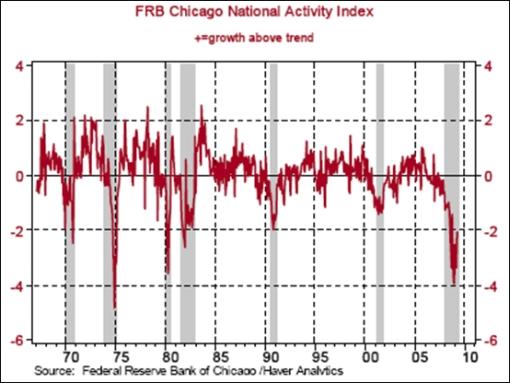
“The Chicago Fed suggests that the month-to-month movements of the index are volatile and recommends the 3-month moving average of the index as a better indicator of national economic growth. The 3-month moving average of the CFNAI was -2.65 in April versus -3.29 in March. This index bottomed out in January 2009 (-3.69).
“Setbacks from the auto industry restructuring should not be surprising. We will need to watch for a few months to confirm that it is not a false signal.”
Source: Asha Bangalore, Northern Trust, May 26, 2009.
Asha Bangalore (Northern Trust): Jobless claims fall but continuing claims continue to advance “Initial jobless claims fell 13,000 to 623,000 during the week ended May 23. Continuing claims, which lag initial claims by one week, rose 110,000 to 6.788 million and the insured unemployment rate hit the 5.1% mark. The number of folks collecting unemployment insurance is troubling but the downward trend of initial jobless claims is the big positive aspect of the report.”
Source: Asha Bangalore (Northern Trust), May 28, 2009.
By Dr Prieur du Plessis
Dr Prieur du Plessis is an investment professional with 25 years' experience in investment research and portfolio management.
More than 1200 of his articles on investment-related topics have been published in various regular newspaper, journal and Internet columns (including his blog, Investment Postcards from Cape Town : www.investmentpostcards.com ). He has also published a book, Financial Basics: Investment.
Prieur is chairman and principal shareholder of South African-based Plexus Asset Management , which he founded in 1995. The group conducts investment management, investment consulting, private equity and real estate activities in South Africa and other African countries.
Plexus is the South African partner of John Mauldin , Dallas-based author of the popular Thoughts from the Frontline newsletter, and also has an exclusive licensing agreement with California-based Research Affiliates for managing and distributing its enhanced Fundamental Index™ methodology in the Pan-African area.
Prieur is 53 years old and live with his wife, television producer and presenter Isabel Verwey, and two children in Cape Town , South Africa . His leisure activities include long-distance running, traveling, reading and motor-cycling.
Copyright © 2009 by Prieur du Plessis - All rights reserved.
Disclaimer: The above is a matter of opinion and is not intended as investment advice. Information and analysis above are derived from sources and utilizing methods believed reliable, but we cannot accept responsibility for any trading losses you may incur as a result of this analysis. Do your own due diligence.
Prieur du Plessis Archive |
© 2005-2022 http://www.MarketOracle.co.uk - The Market Oracle is a FREE Daily Financial Markets Analysis & Forecasting online publication.






